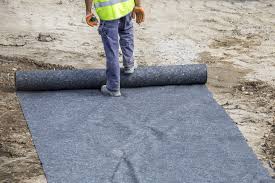GEO TEXTILE
Geotextiles are permeable textile fabrics that are used in conjunction with soil to improve its performance in a wide range of applications. These versatile materials are typically manufactured from synthetic fibers such as polypropylene, polyester, or polyethylene, and are available in various forms, including woven, nonwoven, and knitted.

KEY FUNCTIONS
Seperation
Preventing the mixing of different soil layers, ensuring that each layer maintains its intended properties.
Filtration
Allowing water to pass through while retaining soil particles, preventing erosion and maintaining the integrity of the soil structure.
Reinforcement
Strengthening soil structures and improving their stability, particularly in areas subject to high loads or stresses.
Protection
Shielding soil from erosion, damage, and degradation, extending its lifespan and preventing costly repairs.
Drainage
Facilitating the flow of water through the soil, preventing waterlogging and associated problems, such as settlement and instability.
Common Applications of Geotextiles
Civil Engineering
- Roads
- Railways
- Airports
- Landfills
- Embankments.
Coastal Engineering
- Erosion control
- Breakwaters
- Seawalls.
Environmental Protection
- Groundwater protection.
- Filtration systems.
- Pollution control.
Agriculture
- Drainage systems.
- Erosion control.
- Landscaping.
Benefits of Using Geotextiles
Reduces the likelihood of settlement and failure, ensuring the long-term performance of structures.
Prevents waterlogging and erosion, protecting the soil and minimizing maintenance costs.
Often more economical than traditional methods, providing a long-term solution to soil-related problems.
Resistant to degradation and weathering, ensuring a long service life.
Can help reduce the need for excessive excavation and fill materials, minimizing environmental impact.